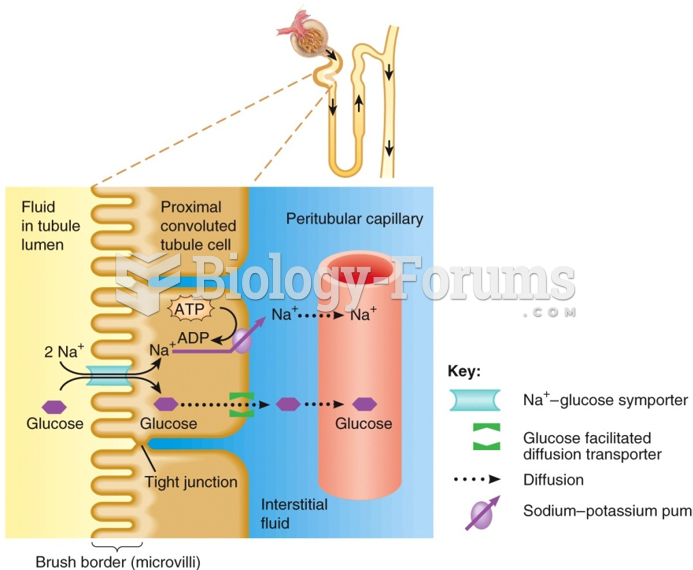Answer to Question 1
Companies that produce, use, store, and/or transport radioactive materials are required to have a signal-generating system that can warn of the need for evacuation. OSHA describes the evacuation warning signal system as follows:
The signal shall be a mid-frequency complex sound wave amplitude modulated at a subsonic frequency. The complex sound wave in free space shall have a fundamental frequency (f1) between 450 and 500 hertz (HZ) modulated at a subsonic rate between 4 and 5 hertz. The signal generator shall not be less than 75 decibels at every location where an individual may be present whose immediate, rapid, and complete evacuation is essential.
In addition to this basic requirement, OSHA also stipulates the following:
A sufficient number of signal generators must be installed to cover all personnel who may need to be evacuated.
The signal shall be unique, unduplicated, and instantly recognizable in the plant where it is located
The signal must be long enough in duration to ensure that all potentially affected employees are able to hear it.
The signal generator must respond automatically without the need for human activation, and it must be fitted with backup power.
Answer to Question 2
Training and education
Failures or deficiencies in hearing loss prevention programs can often be traced to inadequacies in the training and education of noise-exposed workers and those who conduct elements of the program.
Has training been conducted at least once a year?
Was the training provided by a qualified instructor?
Was the success of each training program evaluated?
Is the content revised periodically?
Are managers and supervisors directly involved?
Are posters, regulations, handouts, and employee newsletters used as supplements?
Are personal counseling sessions conducted for employees having problems with hearing protection devices or showing hearing threshold shifts?
Supervisor involvement
Data indicate that employees who refuse to wear hearing protection devices or who fail to show up for hearing tests frequently work for supervisors who are not totally committed to the hearing conservation program.
Have supervisors been provided with the knowledge required to supervise the use and care of hearing protectors by subordinates?
Do supervisors wear hearing protectors in appropriate areas?
Have supervisors been counseled when employees resist wearing protectors or fail to show up for hearing test?
Are disciplinary actions enforced when employees repeatedly refuse to wear hearing protectors?
Noise measurements
Noise measurements, to be useful, should be related to noise exposure risks or the prioritization of noise control efforts, rather than merely filed away. In addition, the results should be communicated to the appropriate personnel, especially when follow-up actions are required.
Were the essential/critical noise studies performed?
Was the purpose of each noise study clearly stated? Have noise-exposed workers been notified of their exposures and apprised of auditory risks?
Are the results routinely transmitted to supervisors and other key individuals?
Are results entered into health/medical records of noise-exposed workers?
Are results entered into shop folders?
If noise maps exist, are they used by the proper staff?
Are noise measurement results considered when contemplating procurement of new equipment? Modifying the facility? Relocating workers?
Have there been changes in areas, equipment, or processes that have altered noise exposure? Have follow-up noise measurements been conducted?
Are appropriate steps taken to include (or exclude) workers in the hearing loss prevention programs whose exposures have changed significantly?
Engineering and administrative controls
Controlling noise by engineering and administrative methods is often the most effective means of reducing or eliminating the hazard. In some cases, engineering controls will remove requirements for other components of the program, such as audiometric testing and the use of hearing protectors.
Have noise control needs been prioritized?
Has the cost-effectiveness of various options been addressed?
Are workers and supervisors apprised of plans for noise control measures?
Are they consulted on various approaches?
Will in-house resources or outside consultants perform the work?
Have workers and supervisors been counseled on the operation and maintenance of noise control devices?
Are noise control projects monitored to ensure timely completion?
Has the full potential for administrative controls been evaluated? Are noisy processes conducted during shifts with fewer employees? Do workers have noise-protected lunch or break areas?
Monitoring audiometry and record keeping
The skills of audiometric technicians, the status of the audiometer, and the quality of audiometric test records are crucial to the success of hearing loss prevention programs. Useful information may be ascertained from the audiometric records as well as from those who actually administer the tests.
Has the audiometric technician been adequately trained, certified, and re-certified as necessary?
Do on-the-job observations of the technicians indicate that they perform a thorough and valid audiometric test, instruct and consult the worker effectively, and keep appropriate records?
Are records complete?
Are follow-up actions documented?
Are hearing threshold levels reasonably consistent from test to test? If not, are the reasons for inconsistencies investigated promptly?
Are the annual test results compared to baseline to identify the presence of an OSHA standard threshold shift?
Is the annual incidence of standard threshold shift greater than a few percent? If so, are problem areas pinpointed and remedial steps taken?
Are audiometric trends (deteriorations) being identified, both in individuals and in groups of employees?
Do records show that appropriate audiometer calibration procedures have been followed?
Is there documentation showing that the background sound levels in the audiometer room were low enough to permit valid testing?
Are the results of audiometric tests being communicated to supervisors and managers as well as to workers?
Has corrective action been taken if the rate of no-shows for audiometric test appointments is more than about five percent?
Are workers incurring significant threshold shift notified in writing within at least 21 days?
Referrals
Referrals to outside sources for consultation or treatment are sometimes in order, but they can be an expensive element of the hearing loss prevention program and should not be undertaken unnecessarily.
Are referral procedures clearly specified?
Have letters of agreement between the company and consulting physicians or audiologists been executed?
Have mechanisms been established to ensure that workers needing evaluation or treatment actually receive the service (i.e., transportation, scheduling, reminders)?
Are records properly transmitted to the physician or audiologist, and back to the company?
If medical treatment is recommended, does the worker understand the condition requiring treatment, the recommendation, and methods of obtaining such treatment?
Are workers being referred unnecessarily?
Hearing protection devices
When noise control measures are not feasible, or until such time as they are installed, hearing protection devices are the only way to prevent hazardous levels of noise from damaging the inner ear. Making sure that these devices are worn properly requires continuous attention on the part of supervisors and program implementers as well as noise-exposed employees.
Have hearing protectors been made available to all employees whose daily average noise exposures are 85 dBA or above?
Are workers given the opportunity to select from a variety of appropriate protectors?
Are workers fitted carefully with special attention to comfort?
Are workers thoroughly trained, not only initially but at least once a year?
Are the protectors checked regularly for wear or defects and replaced immediately if necessary?
If workers use disposable hearing protectors, are replacements readily available?
Do workers understand the appropriate hygiene requirements?
Have any workers developed ear infections or irritations associated with the use of hearing protectors? Are there any workers who are unable to wear these devices because of medical conditions? Have these conditions been treated promptly and successfully?
Have alternative types of hearing protectors been considered when problems with current devices are experienced?
Do workers who incur noise-induced hearing loss receive intensive counseling?
Are those who fit and supervise the wearing of hearing protectors competent to deal with the many problems that can occur?
Do workers complain that protectors interfere with their ability to do their jobs? Do they interfere with spoken instructions or warning signals? Are these complaints followed promptly with counseling, noise control, or other measures?
Are workers encouraged to take their hearing protectors home if they engage in noisy non-occupational activities?
Are potentially more effective protectors considered as they become available?
Is the effectiveness of the hearing protector program evaluated regularly?
Have at-the-ear protection levels been evaluated to ensure that either over- or underprotection has been adequately balanced according to the anticipated ambient noise levels?
Is each hearing protector user required to demonstrate that he or she understands how to use and care for the protector? Are the results documented?
Administration
Keeping organized and current on administrative matters will help the program run smoothly.
Have there been any changes in federal or state regulations? Have hearing loss prevention program's policies been modified to reflect these changes?
Are copies of company policies and guidelines regarding the hearing loss prevention program available in the offices that support the various program elements? Are those who implement the program elements aware of these policies? Do they comply?
Are necessary materials and supplies being ordered with a minimum of delay?
Are procurement officers overriding the hearing loss prevention program implementor's requests for specific hearing protectors or other hearing loss prevention equipment? If so, have corrective steps been taken?
Is the performance of key personnel evaluated periodically? If such performance is found to be less than acceptable, are steps taken to correct the situation?
Has the failure to hear warning shouts or alarms been tied to any accidents or injuries? If so, have remedial steps been taken?







